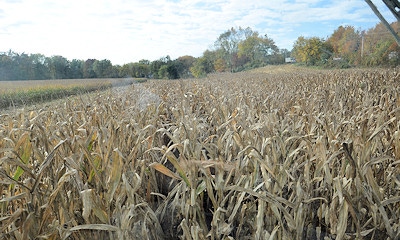
John Mackson was well over 25 miles from home when he attended a meeting in central Indiana recently. That alone would have qualifier him as an expert, but Mackson also has a long career as a soil consultant to back him up. He’s a consulting agronomist with Denning & Associates. He works in the thumb area of the state, near Pinconning, Michigan.
He’s convinced some rules apply no matter where you are. He used his time to refresh Indiana farmers about some basics of soil fertility in a tight budget year.
1. If you’re not sampling soils, then you don’t have a basis for cutting fertilizer rates.

WOULD YOU GRID SAMPLE THIS FIELD? If grid sampling means mixing soil types, you may not learn much in a rolling field like this one.
You might think by today everybody soil samples, but Mackson doesn’t believe that is the case. “If you’re not soil sampling, then you don’t have a basis to know what nutrients you need or what you could cut,” he emphasizes.
2. How you sample soil matters
Mackson is a firm believer in sampling by soil type. “Different soils have different capabilities,” he says.
3. You learn a lot by knowing cation exchange capacity
It’s a measure of how big a bucket you have in the soil to hold nutrients, he says. “You get an idea if you’re dealing with a 5-gallon bucket or a 50-gallon drum,” he says. If you have lower CECs and the five-gallon bucket, you may want to apply less fertilizer more often.
Related: Check soil fertility with tissue tests
4. You can’t turn the whole field into 200-bushel corn ground if it just isn’t 200-bushel corn ground.
Soils simply have different capabilities, Mackson insists. You need to know what the capability of each soil is and treat it accordingly.
5. Mixing two different types of soil in one sample doesn’t tell you what you have
What you want is a representative sample for each location, the corps consultant says. You won’t get it by mixing two very different soils with very different properties.
6. Analyze grid sampling carefully
Whether or not grids will give you reasonable information may depend upon the type of land you have, he notes. If it isn’t uniform and soils vary across grids, he prefers to sample by soil type.
Related: Can you pass this 5-question soil health test?
7. The pH is the lynch pin for everything else in soil fertility
A lot rides on getting the soil pH right. That starts with determining where it is today correctly, he says. Mackson notes that soil pH is the key to availability of so many other nutrients in the soil.
About the Author(s)
You May Also Like




